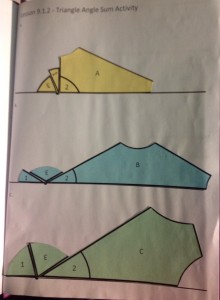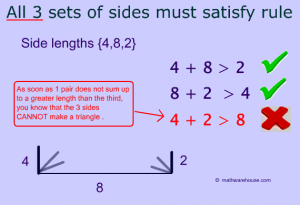Blog 31: Angle Relationships:
Today in class we learned about angle relationships that are in different angles and have different vocabulary. We have learned about, alternate interior angles, vertical angles, corresponding angles, alternate exterior angles, same side interior angles, and same side exterior angles. Other things we learned about were transversal lines and parallel lines. A transversal line is a line cutting through parallel lines, there can be 2 parallel lines or there can be 5 there can be a lot.

Blog 32: Angles in a Triangle:
In math class today we did an activity where we had to calculate the sum of all the triangles that we were given where a half circle equals 180°. The sum of the half circle 180° is also the sum of a triangle. The results are never affected by the size or shape of a triangle, it will always end up with a sum of 180°.
Blog 33: Triangle Inequality:
When the three side lengths compare to each other I see that the sum of the small and medium lengths are greater or less that the large length. The angles that form triangle have sides that are greater than or less than the larger side. The angles that DO NOT form will never form a triangle. If they dont form a triangles that because the small and medium lengths arent greater or less that the larger length .
Blog 34: Triangle Side Length Patterns:
Today in class we learned about the patterns in side lengths of a Triangle. A method we learned was trying to solved problems with the ” Pythagorean Theorem”. We have ti find the square root of the small and the medium lengths. The total of both is called the Hypotenuse, it is the largest square. Once you find the area of both you have to add both numbers together. Then you get the sum and then you find the square root of the number. The number multiplied by itself will give you the area of the number. And when finding the square root if the number isn’t a whole number then you use an approximately sign.
Blog 35: Square roots:
One of the methods we leanred in class was squaring the number, if you dont know what that is it is multiplying the number by itself, a fancy word for it can be square root. When you square root the number you dont square it, you multiply different side lengths or number and add it all up THEN find the square root. You can either use a calculator or actually do the work. There is many cases where you will get a decimal so instead of putting ” Square root = 13.455″ you put “Square root approximately equals 13.455”. Oh another thing since it is 13.455 you round up so it would be 13.5. When trying to find the square root you have to figure out what numbers are in between one another. Then you round and find what number it is closer to.
Blog 36: Pythagorean Therom
Today in class we learned about the Pythagorean Theorem. It is where you find a missing length or missing leg of a triangle. When looking for the missing length you have to also pay attention to the other numbers. If the length is missing you subtract and if the hypotenuse is missing you add. As an example my two other numbers will be 11 and 6, the missing thing will be the hypotenuse, after you have the numbers you will square them. So i squared 6 and got 36, then squared 11 and got 121 after adding the numbers i got 157. After square rooting it i got approximately 12.5. So x= 12.5.









Leave a Reply